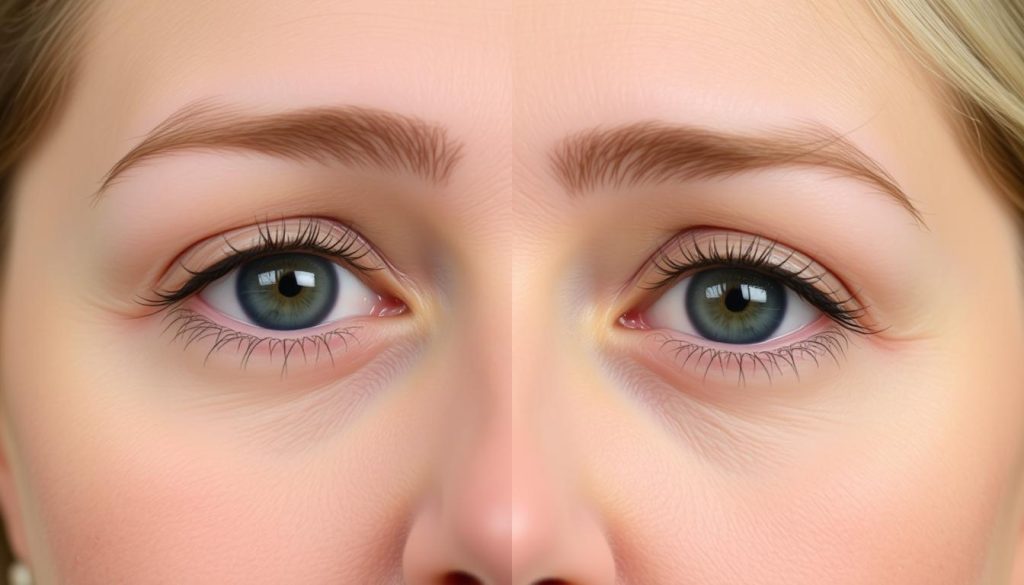Upper eyelid surgery, also known as blepharoplasty, is a game-changer for those looking to refresh their eyes. It can make your eyes look younger and more alert by fixing sagging or drooping eyelids.
Blepharoplasty does more than just make you look good. It can also help if your eyelids are blocking your view. By taking out extra skin and fat, it boosts both how you look and how well you see.
If you’re thinking about this surgery for looks or to fix vision problems, knowing the basics is key. This guide will cover everything about blepharoplasty. It’s here to help you understand your options for eye rejuvenation.
Understanding Upper Eyelid Surgery: A Comprehensive Guide
Upper eyelid surgery, also called blepharoplasty, helps those who want to refresh their eye look or fix vision problems from droopy eyelids. This guide will cover the procedure, its goals, and why people choose an eyelid lift.
What Is Blepharoplasty
Blepharoplasty is a surgery that removes extra skin, muscle, and fat from the upper eyelids. It fixes both looks and function issues from droopy eyelids. The goal is to look more awake and young, and maybe even see better.
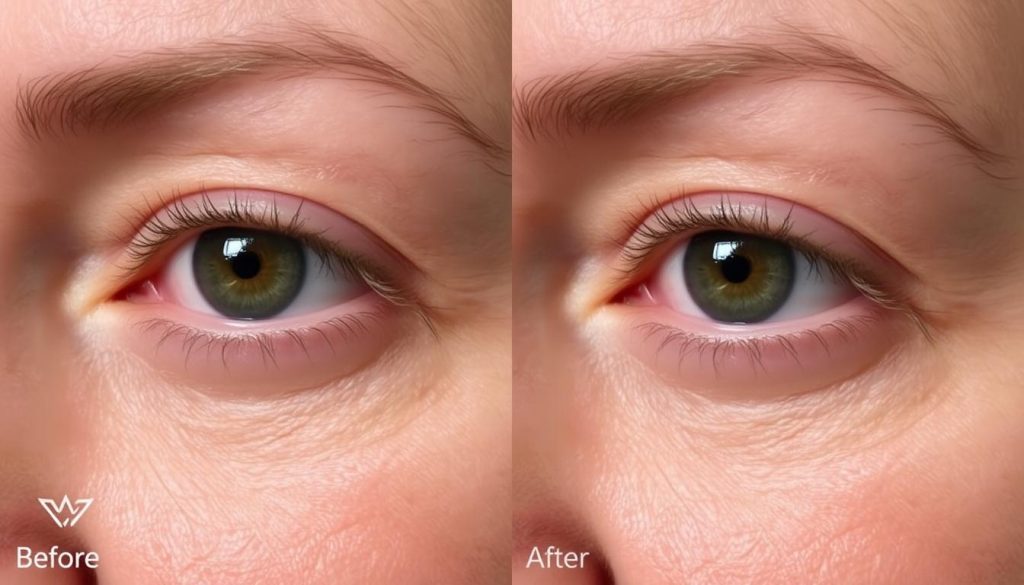
Common Reasons for Seeking Eyelid Surgery
People get eyelid lifts for many reasons:
- To lessen aging signs around the eyes
- To get rid of puffiness or bags under the eyes
- To fix sagging or hooded upper eyelids
- To improve vision blocked by too much skin
Medical vs. Cosmetic Motivations
Eyelid surgery is for both health and beauty. Medical reasons might be vision problems from too much skin. Beauty reasons are about looking younger and refreshed. Your doctor will decide if it’s for health or looks during your visit.
Signs You Might Need Upper Eyelid Surgery
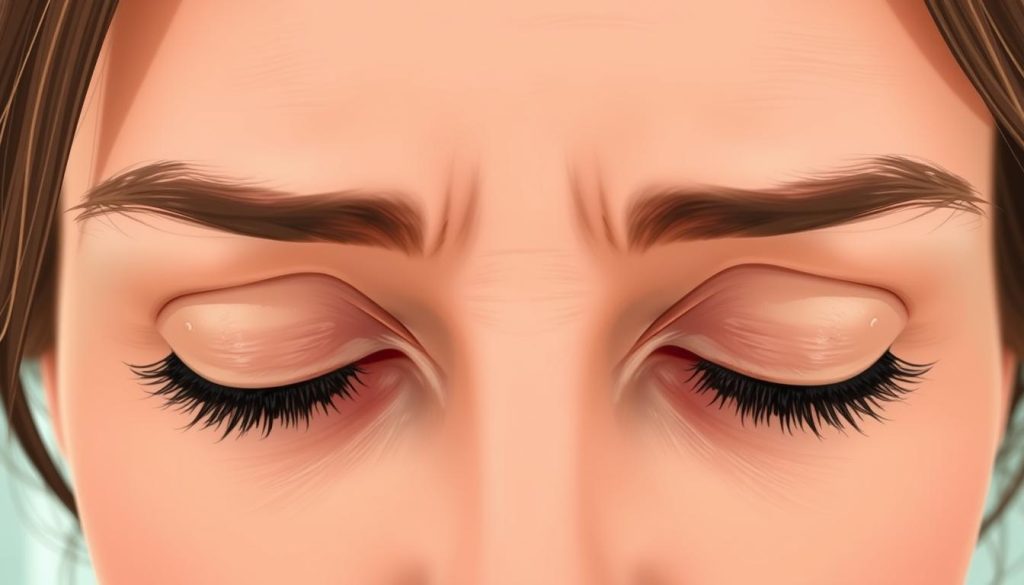
Knowing when you need upper eyelid surgery is key for your looks and sight. If you see too much skin covering your eyes, it might be time for repair. This often happens as we get older, making our eyelids droop and block our view.
Eye bags are another reason for eyelid surgery. Bags under your eyes can make you look tired or older. If makeup can’t hide them, surgery might be the answer.
- Difficulty applying makeup due to excess eyelid skin
- Reduced field of vision, specially in the upper and outer parts
- Constant heavy feeling in the eyelids
- Visible sagging or folding of the upper eyelid skin
Seeing these signs doesn’t mean you definitely need surgery. A pro can tell if you do. They’ll check how it looks and affects your vision. Then, they’ll suggest the best steps.
The Science Behind Aging Eyelids and Vision Impairment
As we get older, our eyelids change a lot. These changes can affect how we look and see. Many people choose eyelid tightening or cosmetic eye surgery to fix these issues.
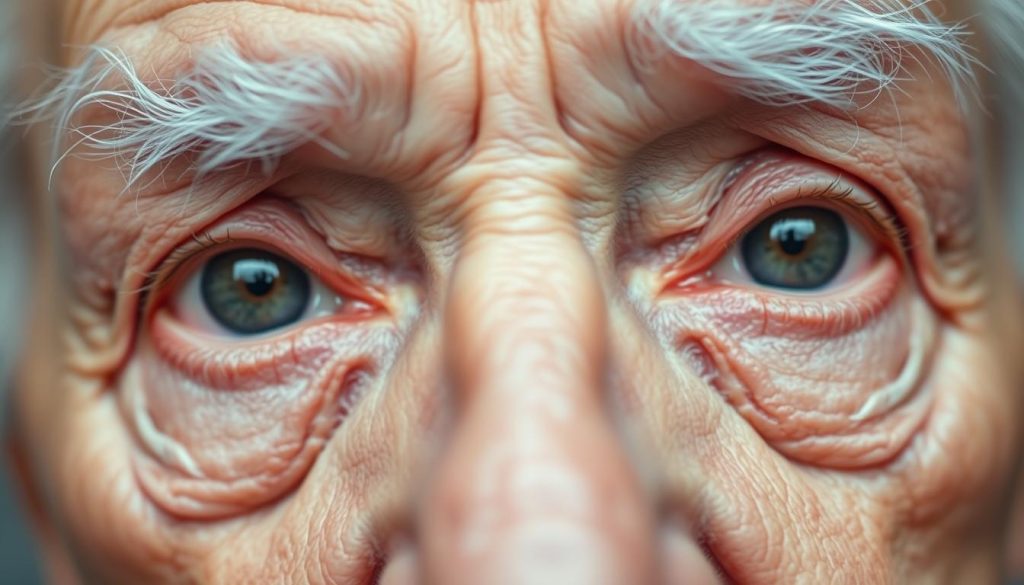
Natural Aging Process of Eye Area
The skin around our eyes is very thin and ages quickly. It loses its stretchiness and collagen, causing it to sag and wrinkle. Fat can also move, making our eyes look puffy or sunken. This can make us look tired or older than we feel.
Impact on Peripheral Vision
Droopy eyelids can block our view, affecting our side vision. This can make everyday tasks like driving or reading harder. In serious cases, it can even be dangerous, leading to the need for surgery.
Role of Genetics in Eyelid Appearance
Our genes also play a big part in how our eyelids age. Some people are more likely to have extra skin or fat around their eyes. This is why some families may have more eyelid issues and why some people might need surgery sooner.
| Factor | Impact on Eyelids | Potential Solution |
|---|---|---|
| Aging | Loss of skin elasticity, sagging | Eyelid tightening |
| Fat Deposits | Puffiness, bags under eyes | Blepharoplasty |
| Genetics | Predisposition to droopy eyelids | Cosmetic eye surgery |
Benefits of Blepharoplasty for Vision and Appearance
Upper eyelid surgery offers many benefits for both vision and looks. This procedure, known as blepharoplasty, can change your eyes and improve your overall look.
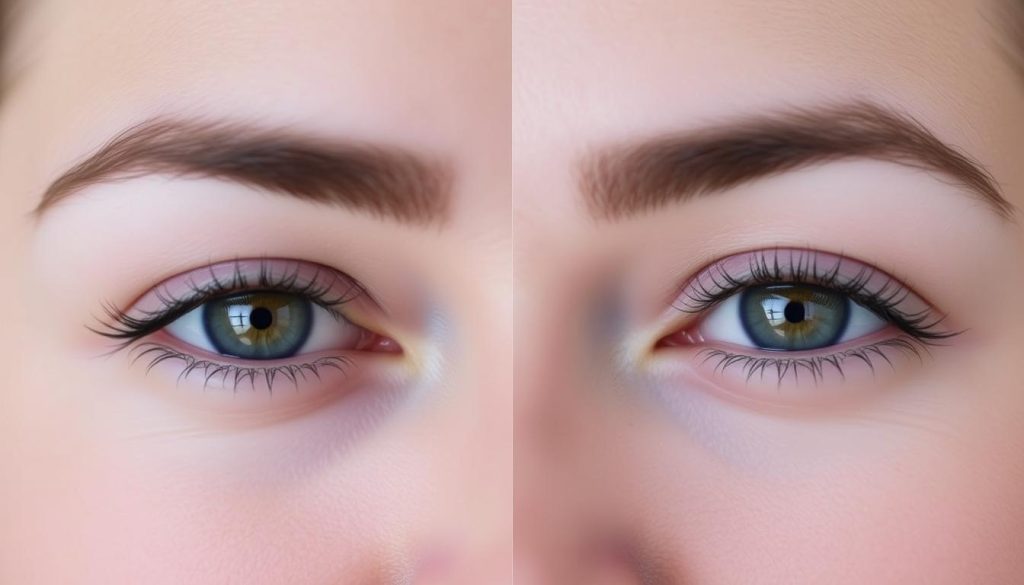
Eye rejuvenation through upper eyelid surgery can greatly improve your vision. By removing excess skin that may be covering your eyes, you’ll see more clearly. This is great for everyday tasks like reading or driving.
The looks benefits of blepharoplasty are also amazing. Many people say they look more awake and younger after the surgery. It can also reduce puffiness and make your eyelids look smoother, giving you a fresh look.
| Vision Benefits | Appearance Benefits |
|---|---|
| Expanded visual field | More alert look |
| Improved peripheral vision | Youthful appearance |
| Enhanced clarity | Reduced puffiness |
| Less eye strain | Smoother eyelid contours |
Upper eyelid surgery does more than just change how you look. It can also make you feel more confident and improve your life. People often feel more at ease in social situations and are happier with how they look.
“Upper eyelid surgery gave me a new lease on life. I can see better, and I feel years younger!”
If you’re thinking about eye rejuvenation, upper eyelid surgery might be what you need. Talk to a skilled surgeon to learn more about your options and the benefits.
Pre-Surgery Consultation and Planning Process
Getting ready for blepharoplasty or eyelid lift surgery starts with a detailed consultation. This important step helps make sure you get the best results from the surgery.
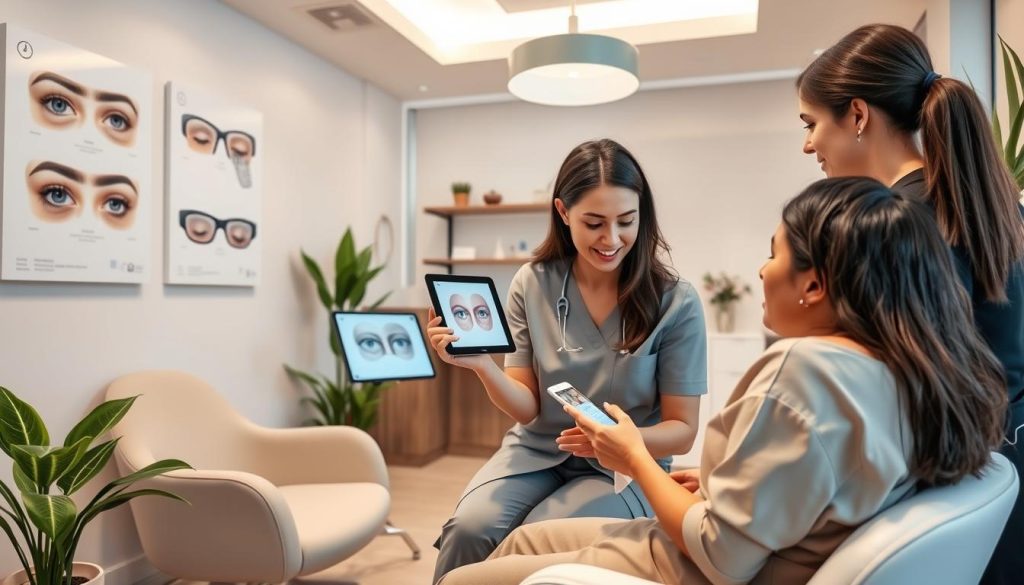
Medical History Review
Your surgeon will look over your medical history during the first meeting. They’ll check for past eye surgeries, current medicines, and any health issues that could impact the surgery or healing.
Eye Examination Requirements
Before eyelid lift surgery, a detailed eye exam is needed. This includes:
- Visual acuity tests
- Peripheral vision assessment
- Eyelid measurements
- Tear production evaluation
These tests help figure out if you’re a good candidate for blepharoplasty. They also help plan the surgery.
Setting Realistic Expectations
Talking openly with your surgeon is important for setting goals. Discuss what you hope to achieve and what blepharoplasty can do. Your surgeon will share what the surgery can and can’t do based on your eyes.
| Consultation Step | Purpose |
|---|---|
| Medical History Review | Identify possible risks and things you shouldn’t do |
| Eye Examination | Check your eye health and plan the surgery |
| Expectation Setting | Make sure your goals match what’s possible |
By covering these points in the consultation, you and your surgeon can create a plan for your eyelid lift. This ensures the best results from your blepharoplasty surgery.
Advanced Surgical Techniques in Modern Blepharoplasty
Upper eyelid surgery has made huge strides. Today, it uses the latest methods for better results. These new techniques make the surgery safer and more effective.
Now, surgery is done with tiny incisions. This means less scarring and quicker healing. It’s perfect for those wanting a youthful look without a long recovery.
Laser-assisted procedures are another big step forward. Lasers help remove tissue precisely and seal blood vessels as they cut. This results in less bleeding and swelling after surgery.
New suturing methods are also improving results. These methods create nearly invisible scars and help healing happen faster. This means patients can enjoy their refreshed look sooner.
- Smaller incisions for less visible scars
- Laser technology for precision and reduced bleeding
- Innovative suturing for quicker recovery
These modern techniques not only improve looks but also make surgery more comfortable. With less trauma to the delicate eye area, recovery is smoother and faster than before.
As cosmetic eye surgery keeps evolving, patients can look forward to even better results. The future of upper eyelid surgery looks bright, with ongoing research promising even more advanced techniques.
Step-by-Step Upper Eyelid Surgery Procedure
Upper eyelid surgery, also known as blepharoplasty, makes the eye area look younger. This guide will walk you through the steps, from anesthesia to moving tissues.
Anesthesia Options
There are different anesthesia choices for blepharoplasty. Local anesthesia numbs the area around your eyes, but you stay awake. Twilight sedation makes you relaxed but aware. General anesthesia puts you to sleep during the surgery.
Your doctor will choose the best option for you. They consider your health and comfort.
Incision Placement Strategies
Surgeons carefully place incisions to hide scars. They usually cut along the natural crease of your upper eyelid. This method helps your scars fade away once you heal.
Tissue Removal and Repositioning
The main part of blepharoplasty is removing extra skin and fat. Surgeons take out loose skin that makes your eyelids droop. They might also move fat to smooth out your eyes.
This makes your eyes look more youthful and alert. Surgeons aim for natural results. They want to enhance your eyes without changing your face.
Recovery Timeline and Post-Operative Care
After upper eyelid surgery, patients start a healing journey. The first week is key for eye rejuvenation. Swelling and bruising peak around day three but start going down after that.
Most people go back to work in 7-10 days. But, it takes several weeks for full healing.
- Apply cold compresses to reduce swelling
- Keep your head elevated while sleeping
- Use prescribed eye drops to prevent infection
- Avoid strenuous activities for at least two weeks
- Protect your eyes from sun and wind
Pain is usually minimal and can be managed with over-the-counter meds. Stitches are removed after a week. It’s important to have follow-up appointments to check on your progress.
Full recovery can take up to three months. You’ll see gradual improvements in your eyelids during this time. Being patient is important – the results will be worth it.
“The recovery process is just as important as the surgery itself. Following your doctor’s instructions carefully ensures the best possible outcome.”
Everyone heals at their own pace. Some might recover faster, while others need more time. Always talk to your surgeon if you have any concerns during recovery.
Potential Risks and Complications to Consider
Upper eyelid surgery, or blepharoplasty, is a common procedure. While generally safe, it’s important to understand the risks. We’ll look at common side effects, rare complications, and how to prevent them.
Common Side Effects
After blepharoplasty, patients may see swelling and bruising. Dry eyes are also common. These usually go away in a few weeks.
Rare Complications
Though rare, serious complications can happen. These include infection, vision changes, or asymmetry. In very rare cases, blindness has been reported.
Prevention Strategies
To lower risks, follow your surgeon’s advice before and after surgery. Choose a board-certified plastic surgeon with experience in upper eyelid surgery. Keeping clean and following medication schedules is key.
| Risk Level | Complication | Prevention Strategy |
|---|---|---|
| Common | Swelling | Cold compresses, head elevation |
| Common | Dry eyes | Lubricating eye drops |
| Rare | Infection | Sterile technique, antibiotic use |
| Very Rare | Vision changes | Careful surgical planning |
Understanding these risks and taking preventive steps can help. Always talk to your surgeon about any worries before getting upper eyelid surgery.
Combining Upper Eyelid Surgery with Other Procedures
Upper eyelid surgery can be made better by adding other procedures. Many people choose to get a brow lift with their eyelid surgery. This combo tackles sagging eyebrows and extra eyelid skin, making the face look younger and more awake.
Eye bag removal is also a common choice to go with eyelid surgery. It covers both the upper and lower eyelids, giving a balanced look. This approach often leads to more noticeable improvements in how the face looks.
| Procedure Combination | Benefits | Considerations |
|---|---|---|
| Upper Eyelid Surgery + Brow Lift | Comprehensive upper face rejuvenation | Longer recovery time |
| Upper Eyelid Surgery + Eye Bag Removal | Complete eye area transformation | Increased risk of complications |
| Upper Eyelid Surgery + Facelift | Full facial rejuvenation | Higher cost and extended recovery |
Combining procedures can save money and shorten recovery time. You only need one anesthesia session and recovery period. It’s important to talk to a board-certified plastic surgeon to find the best treatment for your face and goals.
Cost Factors and Insurance Coverage
Understanding the cost of eyelid lift surgery is key for those thinking about it. The price can change a lot based on different things. It’s important to do your research and plan well.
Price Range Variables
The cost of an eyelid lift can be between $2,000 and $5,000. This depends on the surgeon’s skill, where you are, and the facility’s fees. In big cities, prices go up because of higher costs and more demand for skilled surgeons.
Insurance Requirements
Health insurance usually doesn’t pay for cosmetic eye surgery. But, if an eyelid lift is needed for vision problems, insurance might cover it. Patients need to pass specific tests to show they have vision issues for insurance to approve.
Financing Options
Many clinics have financing plans to help with the cost of an eyelid lift. You can get medical credit cards, personal loans, or in-house payment plans. Some people use health savings accounts (HSAs) or flexible spending accounts (FSAs) to pay with pre-tax dollars.
| Financing Option | Pros | Cons |
|---|---|---|
| Medical Credit Cards | Immediate approval, promotional rates | High interest after promo period |
| Personal Loans | Fixed interest rates, flexible terms | May require good credit score |
| In-House Payment Plans | Direct arrangement with clinic | Limited flexibility, may have fees |
Talking about the financial side with your surgeon is vital. This ensures you’re okay with the cost for your looks and vision.
Selecting the Right Surgeon for Your Procedure
Finding the right surgeon for your upper eyelid surgery is very important. Look for a doctor who is board certified and has special training in oculoplastic procedures. It’s also key to find someone with lots of experience in blepharoplasty for the best results.
Do your homework on possible surgeons. Check out their before-and-after photos of blepharoplasty patients. These pictures can show you their skill and style. Also, read what other patients have to say to learn more about their experiences.
Set up meetings with a few surgeons. This way, you can compare their methods and find one you feel at ease with. Ask them about their experience with upper eyelid surgery and what they suggest for your case.
| Criteria | Why It’s Important |
|---|---|
| Board Certification | Ensures the surgeon meets high standards of training and expertise |
| Specialization in Oculoplastic Surgery | Indicates focused expertise in eyelid procedures |
| Years of Experience | Reflects the surgeon’s proficiency in performing blepharoplasty |
| Before-and-After Photos | Demonstrates the surgeon’s ability to achieve natural-looking results |
| Patient Reviews | Provides insight into patient satisfaction and experiences |
Your comfort with the surgeon is the most important thing. Pick a doctor who listens, explains things clearly, and is realistic about what you can expect from your surgery.
Long-Term Results and Maintenance
Upper eyelid surgery, or blepharoplasty, gives you lasting eye rejuvenation. While the results last a long time, they’re not forever. Knowing how long your results will last and how to keep them looking fresh is important.
Expected Duration of Results
The effects of upper eyelid surgery usually last 5 to 7 years. Some people enjoy their results for up to 10 years or more. Your skin quality, age, and genetics can affect how long your results last.
| Age Group | Average Duration |
|---|---|
| 30-40 years | 7-10 years |
| 40-50 years | 5-7 years |
| 50+ years | 4-6 years |
Lifestyle Factors Affecting Longevity
Your daily habits greatly affect how long your eye rejuvenation lasts. Protecting your eyes from the sun is very important. Wear sunglasses and apply SPF to the eye area every day. A good skincare routine, including moisturizing and using eye creams, helps keep your skin elastic.
- Avoid smoking
- Stay hydrated
- Eat a balanced diet rich in antioxidants
- Get adequate sleep
Regular check-ups with your surgeon are important. They help keep an eye on your results and address any issues early. Remember, while hooded eyelid repair greatly improves your look, it can’t stop aging completely. Living a healthy lifestyle is essential to keeping your look refreshed.
Non-Surgical Alternatives to Consider
If you want to tighten your eyelids without surgery, there are many non-invasive options. These can help with mild sagging and offer quick fixes.
Botox injections are a favorite choice. They can lift the brow, making your eyes look more open. This effect lasts 3-4 months and doesn’t require much downtime.
Dermal fillers are another way to refresh the eye area. They add volume to make sagging skin less noticeable. The effects can last 6-12 months, depending on the product.
Non-invasive skin tightening treatments use radiofrequency or ultrasound. They boost collagen, making the skin around your eyes tighter over time.
| Treatment | Duration of Results | Downtime |
|---|---|---|
| Botox | 3-4 months | Minimal |
| Dermal Fillers | 6-12 months | 1-2 days |
| RF/Ultrasound | 6-12 months | None |
These options can give you noticeable improvements. But, they might not last as long as surgery for serious sagging. Talking to a professional can help find the best solution for you.
Patient Success Stories and Testimonials
Real-life stories of upper eyelid surgery show its impact. Sarah, a 52-year-old teacher, wanted to fix her droopy eyelids. “After surgery, I felt like I’d taken years off my appearance. My eyes look more open and alert,” she shared.
Many patients see both functional and cosmetic gains. Tom, a 60-year-old retiree, saw big vision improvements. “The heavy feeling above my eyes is gone. I can see so much better now, even when driving,” he explained. These stories show how surgery can improve daily life and boost confidence.
Results vary, but most patients are very happy. Emily, a 45-year-old executive, said her eyes look refreshed but natural. “It’s subtle but makes a big difference,” she noted. These testimonials stress the need for realistic expectations and understanding that results can vary.
FAQ
Q: What is upper eyelid surgery?
A: Upper eyelid surgery, also known as blepharoplasty, removes excess skin and fat. It improves appearance and vision. It makes eyes look younger and can improve peripheral vision.
Q: Who is a good candidate for upper eyelid surgery?
A: People with too much skin or fat in their upper eyelids are good candidates. This includes those with a hooded or droopy look. They should be healthy and have realistic expectations.
Q: How long does the recovery process take after upper eyelid surgery?
A: Recovery time varies, but most can get back to normal in 7-10 days. Swelling and bruising go away in 2-3 weeks. It takes months to see the full results.
Q: Are the results of upper eyelid surgery permanent?
A: Results last many years, but aging doesn’t stop. Skin quality, lifestyle, and genetics affect how long it lasts.
Q: Is upper eyelid surgery covered by insurance?
A: Insurance might cover it if it’s needed for vision. Cosmetic procedures aren’t covered. You need a vision test and proof of vision problems for approval.
Q: What are the risks associated with upper eyelid surgery?
A: Risks include infection, bleeding, and scarring. Rare but serious risks are vision loss and eyelid problems. Choosing a skilled surgeon and following instructions can reduce risks.
Q: Can upper eyelid surgery be combined with other procedures?
A: Yes, it can be combined with other treatments for a full facial refresh. Options include brow lifts and lower eyelid surgery. Talk to your surgeon about what’s best for you.
Q: How do I choose the right surgeon for my upper eyelid surgery?
A: Look for a board-certified surgeon with experience in blepharoplasty. Check their before-and-after photos. Discuss your goals and see if you feel comfortable with them.
Q: Are there non-surgical alternatives to upper eyelid surgery?
A: Yes, there are non-surgical options. They offer subtle and temporary results. Options include Botox, fillers, and skin tightening treatments. They’re good for mild cases or if you’re not ready for surgery.
Q: How soon after surgery can I wear makeup?
A: Wait at least two weeks before wearing eye makeup. This helps with healing and prevents infection. Always follow your surgeon’s advice for the best results.












